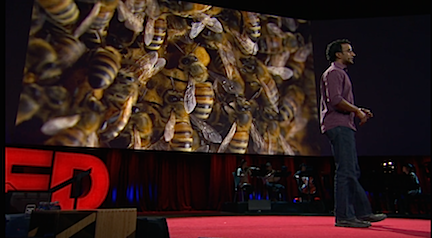A TED talk with great bee footage and some clarification.
My friend Megg tagged me in a Facebook post that included a link to a TED talk titled “A Thrilling Look at the First 21 Days of a Bee’s Life.” If you haven’t seen this yet, you should watch it. It includes the most amazing footage of a bee hatching from an egg and developing from a larvae to an adult bee.
Watch it now. I’ll wait.
Wasn’t that amazing?
But I do need to set the record straight. During the presentation, the speaker, Anand Varma, says that beekeepers use chemicals to treat for mites. Although we can use chemicals, not all of us do. There are other non-chemical treatment methods. I use a combination of drone frames and screened bottom boards.
- I’ve blogged about mites and drone frames:
• Bees: Installing Drone Frames
• Bees: the Drone Frames Really Do Work
• Bees: More about MitesDrone frames encourage the queen to lay more drone eggs, which the mites prefer because they have a longer gestation period. I then kill the developing drone larvae and the mites with them by freezing them (or feeding them to my chickens). I can reuse the drone frames.
- Screen bottom boards replace the solid bottom of a hive with a screen that bees can walk on but mites fall through. Once they fall through, they can’t climb back into the hive. Sticky boards can also be used beneath screens to catch the mites and count them to estimate infestation levels.
A third technique I’ll try this year is using powdered sugar. You dust the bees with sugar and they clean each other off. As they clean off, the mites fall off and, if there’s a screened bottom board, they fall thought and exit the hive.
I believe that consistent and proper use of all three methods can reduce mite infestations without chemicals.
So while genetically engineered bees might be one solution that could be better, beekeepers have other cheaper and easier options available to us.
Discover more from An Eclectic Mind
Subscribe to get the latest posts sent to your email.


I like your approach to practical bee science. Smart mite reduction without poisons seems the better way.
I hear that California’s bees work especially hard. That they are hauled from orchard to orchard on big trucks. Is that the case?
Bob
Yes, they bring millions of bees from all over the United States into California in February for almond pollination. (California produces 80% of the world’s almonds.) Hives are put on pallets and then loaded onto large flatbed trucks. At the orchards, they’re offloaded and placed at intervals for 2-4 weeks before being removed and sometimes put on other crops.
Here’s an article about it: http://www.bbc.com/news/science-environment-21741651
Hi Maria,
I should have clarified that I was referring to “commercial beekeepers” when I said beekeepers typically use chemicals to manage their mite problems. You are absolutely right there are many chemical free mite management options, but the larger operations I talked to all relied on miticides.
Best,
Anand
I suspected you might mean commercial beekeepers. They have so many hives to attend to that drone frames would be a pain in the butt and screened bottom boards would be costly. Thanks for clarifying this for me and my readers. And THANKS SO MUCH for sharing some amazing video about the development of bees!
Hi Maria,
I am in Vermont, and a 3rd year beekeeper. I have discovered a commerical beekeeper in the Champlain Valley of Vermont (Kirk Webster) who has successfully in maintaining his population of bees without treatment since 2002. You should check him out at kirkwebster.com. Keep up the good work.
Jim
Thanks for this tip. I’m always interested in exploring new ideas to take care of my bees.